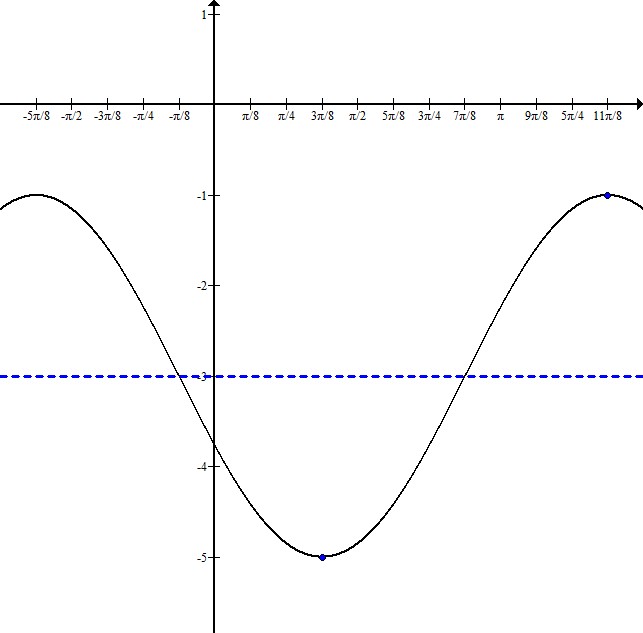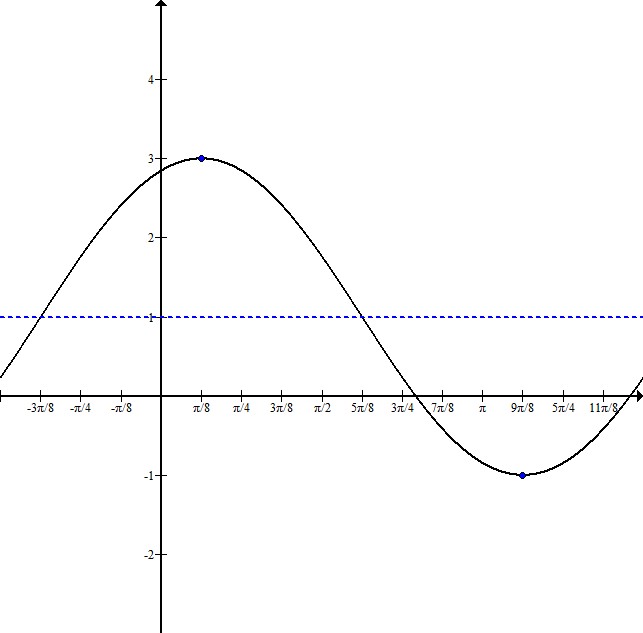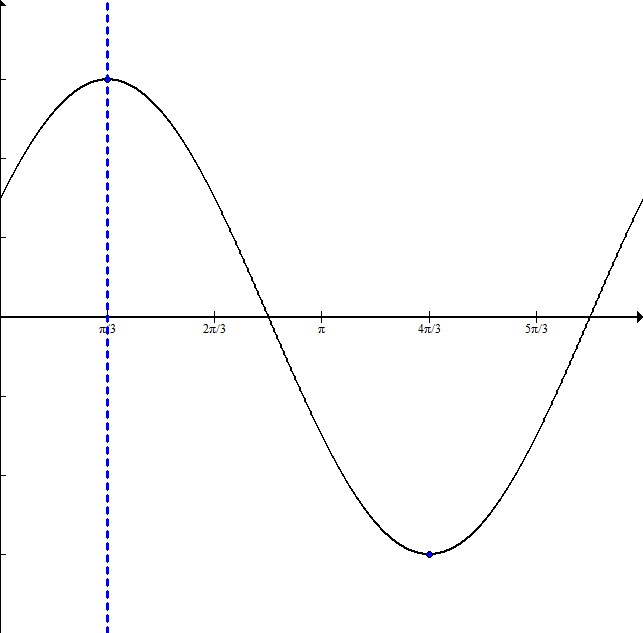Graphing the Sine and Cosine Functions - Pre-Calculus
Card 0 of 88
Please choose the best answer from the following choices.
Find the period of the following function in radians:

Please choose the best answer from the following choices.
Find the period of the following function in radians:
Tap to see back →
If you look at a graph, you can see that the period (length of one wave) is  . Without the graph, you can divide
. Without the graph, you can divide  with the frequency, which in this case, is 1.
with the frequency, which in this case, is 1.
If you look at a graph, you can see that the period (length of one wave) is 

Which of the given functions has the greatest amplitude?
Which of the given functions has the greatest amplitude?
Tap to see back →
The amplitude of a function is the amount by which the graph of the function travels above and below its midline. When graphing a sine function, the value of the amplitude is equivalent to the value of the coefficient of the sine. Similarly, the coefficient associated with the x-value is related to the function's period. The largest coefficient associated with the sine in the provided functions is 2; therefore the correct answer is  .
.
The amplitude is dictated by the coefficient of the trigonometric function. In this case, all of the other functions have a coefficient of one or one-half.
The amplitude of a function is the amount by which the graph of the function travels above and below its midline. When graphing a sine function, the value of the amplitude is equivalent to the value of the coefficient of the sine. Similarly, the coefficient associated with the x-value is related to the function's period. The largest coefficient associated with the sine in the provided functions is 2; therefore the correct answer is 
The amplitude is dictated by the coefficient of the trigonometric function. In this case, all of the other functions have a coefficient of one or one-half.
What is the amplitude of  ?
?
What is the amplitude of 
Tap to see back →
For any equation in the form  , the amplitude of the function is equal to
, the amplitude of the function is equal to  .
.
In this case,  and
and  , so our amplitude is
, so our amplitude is  .
.
For any equation in the form 

In this case, 


What is the amplitude of  ?
?
What is the amplitude of 
Tap to see back →
The formula for the amplitude of a sine function is  from the form:
from the form:
 .
.
In our function,  .
.
Therefore, the amplitude for this function is  .
.
The formula for the amplitude of a sine function is 

In our function, 
Therefore, the amplitude for this function is 
Find the amplitude of the following trig function: 
Find the amplitude of the following trig function:
Tap to see back →
Rewrite  so that it is in the form of:
so that it is in the form of:


The absolute value of  is the value of the amplitude.
is the value of the amplitude.

Rewrite 
The absolute value of 
Find the amplitude of the function.

Find the amplitude of the function.
Tap to see back →
For the sine function
 where
where 
the amplitude is given as  .
.
As such the amplitude for the given function
 is
is
 .
.
For the sine function

the amplitude is given as 
As such the amplitude for the given function


Given  , what is the period for the function?
, what is the period for the function?
Given 
Tap to see back →
The formula for the period of a sine/cosine function is  .
.
With the standard form being:

Since  , the formula becomes
, the formula becomes  .
.
Simplified, the period is  .
.
The formula for the period of a sine/cosine function is 
With the standard form being:
Since 

Simplified, the period is 
What could be the function for the following graph?

What could be the function for the following graph?
Tap to see back →
What could be the function for the following graph?

Begin by realizing we are dealing with a periodic function, so sine and cosine are your best bet.
Next, note that the range of the function is  and that the function goes through the point
and that the function goes through the point  .
.
From this information, we can find the amplitude:

So our function must have a  out in front.
out in front.
Also, from the point  , we can deduce that the function has a vertical translation of positive two.
, we can deduce that the function has a vertical translation of positive two.
The only remaining obstacle, is whether the function is sine or cosine. Recall that sine passes through  , while cosine passes through
, while cosine passes through  . this means that our function must be a sine function, because in order to be a cosien graph, we would need a horizontal translation as well.
. this means that our function must be a sine function, because in order to be a cosien graph, we would need a horizontal translation as well.
Thus, our answer is:

What could be the function for the following graph?
Begin by realizing we are dealing with a periodic function, so sine and cosine are your best bet.
Next, note that the range of the function is 

From this information, we can find the amplitude:
So our function must have a 
Also, from the point 
The only remaining obstacle, is whether the function is sine or cosine. Recall that sine passes through 

Thus, our answer is:
What is the period of this sine graph?

What is the period of this sine graph?

Tap to see back →
The graph has 3 waves between 0 and  , meaning that the length of each of the waves is
, meaning that the length of each of the waves is  divided by 3, or
divided by 3, or  .
.
The graph has 3 waves between 0 and 


What is the period of this graph?

What is the period of this graph?

Tap to see back →
One wave of the graph goes exactly from 0 to  before repeating itself. This means that the period is
before repeating itself. This means that the period is  .
.
One wave of the graph goes exactly from 0 to 

Please choose the best answer from the following choices.
Find the period of the following function.

Please choose the best answer from the following choices.
Find the period of the following function.
Tap to see back →
The period is defined as the length of one wave of the function. In this case, one full wave is 180 degrees or  radians. You can figure this out without looking at a graph by dividing
radians. You can figure this out without looking at a graph by dividing  with the frequency, which in this case, is 2.
with the frequency, which in this case, is 2.
The period is defined as the length of one wave of the function. In this case, one full wave is 180 degrees or 

Write the equation for a cosine graph with a minimum at  and a maximum at
and a maximum at  .
.
Write the equation for a cosine graph with a minimum at 

Tap to see back →
The equation for this graph will be in the form  where A is the amplitude, f is the frequency, h is the horizontal shift, and k is the vertical shift.
where A is the amplitude, f is the frequency, h is the horizontal shift, and k is the vertical shift.
To write this equation, it is helpful to sketch a graph:

From sketching the maximum and the minimum, we can see that the graph is centered at  and has an amplitude of 2.
and has an amplitude of 2.
The distance between the maximum and the minimum is half the wavelength. Here, it is  . That means that the full wavelength is
. That means that the full wavelength is  , so the frequency is 1.
, so the frequency is 1.
The minimum occurs in the middle of the graph, so to figure out where it starts, subtract  from the minimum's x-coordinate:
from the minimum's x-coordinate:

This graph's equation is
 .
.
The equation for this graph will be in the form 
To write this equation, it is helpful to sketch a graph:

From sketching the maximum and the minimum, we can see that the graph is centered at 
The distance between the maximum and the minimum is half the wavelength. Here, it is 

The minimum occurs in the middle of the graph, so to figure out where it starts, subtract 
This graph's equation is

Give the period and frequency for the equation  .
.
Give the period and frequency for the equation 
Tap to see back →
Our equation is in the form 
where A is the amplitude, f is the frequency, h is the horizontal shift, and k is the vertical shift.
We can look at the equation and see that the frequency,  , is
, is  .
.
The period is  , so in this case
, so in this case  .
.
Our equation is in the form
where A is the amplitude, f is the frequency, h is the horizontal shift, and k is the vertical shift.
We can look at the equation and see that the frequency, 

The period is 

What is the period of the graph  ?
?
What is the period of the graph 
Tap to see back →
The equation for this function is in the form 
where A is the amplitude, f is the frequency, h is the horizontal shift, and k is the vertical shift.
By looking at the equation, we can see that the frequency,  , is
, is  .
.
The period is  , so in this case
, so in this case  .
.
The equation for this function is in the form
where A is the amplitude, f is the frequency, h is the horizontal shift, and k is the vertical shift.
By looking at the equation, we can see that the frequency, 

The period is 

Find the phase shift of  .
.
Find the phase shift of 
Tap to see back →
In the formula,
 .
.
 represents the phase shift.
represents the phase shift.
Plugging in what we know gives us:
 .
.
Simplified, the phase is then  .
.
In the formula,


Plugging in what we know gives us:

Simplified, the phase is then 
Which equation would produce this graph?

Which equation would produce this graph?
Tap to see back →
This is the graph of sine, but shifted to the right  units. To reflect this shift,
units. To reflect this shift,  should be subtracted from x.
should be subtracted from x.
Thus resulting in
 .
.
This is the graph of sine, but shifted to the right 

Thus resulting in

Which equation would produce this sine graph?

Which equation would produce this sine graph?
Tap to see back →
The graph has an amplitude of 2 but has been shifted down 1:

In terms of the equation, this puts a 2 in front of sin, and -1 at the end.
This makes it easier to see that the graph starts \[is at 0\] where  .
.
The phase shift is  to the right, or
to the right, or  .
.
The graph has an amplitude of 2 but has been shifted down 1:
In terms of the equation, this puts a 2 in front of sin, and -1 at the end.
This makes it easier to see that the graph starts \[is at 0\] where 
The phase shift is 

Please choose the best answer from the following choices.
Describe the phase shift of the following function:

Please choose the best answer from the following choices.
Describe the phase shift of the following function:
Tap to see back →
Since  is being added inside the parentheses, there will be a horizontal shift. The goal is to maintain zero within the parentheses so you will shift left
is being added inside the parentheses, there will be a horizontal shift. The goal is to maintain zero within the parentheses so you will shift left  radians.
radians.
Since 

Write the equation for a sine graph with a maximum at  and a minimum at
and a minimum at  .
.
Write the equation for a sine graph with a maximum at 

Tap to see back →
To write this equation, it is helpful to sketch a graph:

Indicating the maximum and minimum points, we can see that this graph has been shifted up 1, and it has an amplitude of 2.
The distance from the maximum to the minimum point is half the wavelength. In this case, the wavelength is  . That means the full wavelength is
. That means the full wavelength is  , and the frequency is 1.
, and the frequency is 1.
This sketch shows that the graph starts to the left of the y-axis. To figure out exactly where, subtract  from the maximum x-coordinate,
from the maximum x-coordinate,  :
:
 .
.
Our equation will be in the form  where A is the amplitude, f is the frequency, h is the horizontal shift, and k is the vertical shift.
where A is the amplitude, f is the frequency, h is the horizontal shift, and k is the vertical shift.
This graph has an equation of
 .
.
To write this equation, it is helpful to sketch a graph:

Indicating the maximum and minimum points, we can see that this graph has been shifted up 1, and it has an amplitude of 2.
The distance from the maximum to the minimum point is half the wavelength. In this case, the wavelength is 

This sketch shows that the graph starts to the left of the y-axis. To figure out exactly where, subtract 


Our equation will be in the form 
This graph has an equation of

Write the equation for a cosine graph with a maximum at  and a minimum at
and a minimum at  .
.
Write the equation for a cosine graph with a maximum at 

Tap to see back →
In order to write this equation, it is helpful to sketch a graph:

The dotted line is at  , where the maximum occurs and therefore where the graph starts. This means that the graph is shifted to the right
, where the maximum occurs and therefore where the graph starts. This means that the graph is shifted to the right  .
.
The distance from the maximum to the minimum is half the entire wavelength. Here it is  .
.
Since half the wavelength is  , that means the full wavelength is
, that means the full wavelength is  so the frequency is just 1.
so the frequency is just 1.
The amplitude is 3 because the graph goes symmetrically from -3 to 3.
The equation will be in the form  where A is the amplitude, f is the frequency, h is the horizontal shift, and k is the vertical shift.
where A is the amplitude, f is the frequency, h is the horizontal shift, and k is the vertical shift.
This equation is
 .
.
In order to write this equation, it is helpful to sketch a graph:

The dotted line is at 

The distance from the maximum to the minimum is half the entire wavelength. Here it is 
Since half the wavelength is 

The amplitude is 3 because the graph goes symmetrically from -3 to 3.
The equation will be in the form 
This equation is
